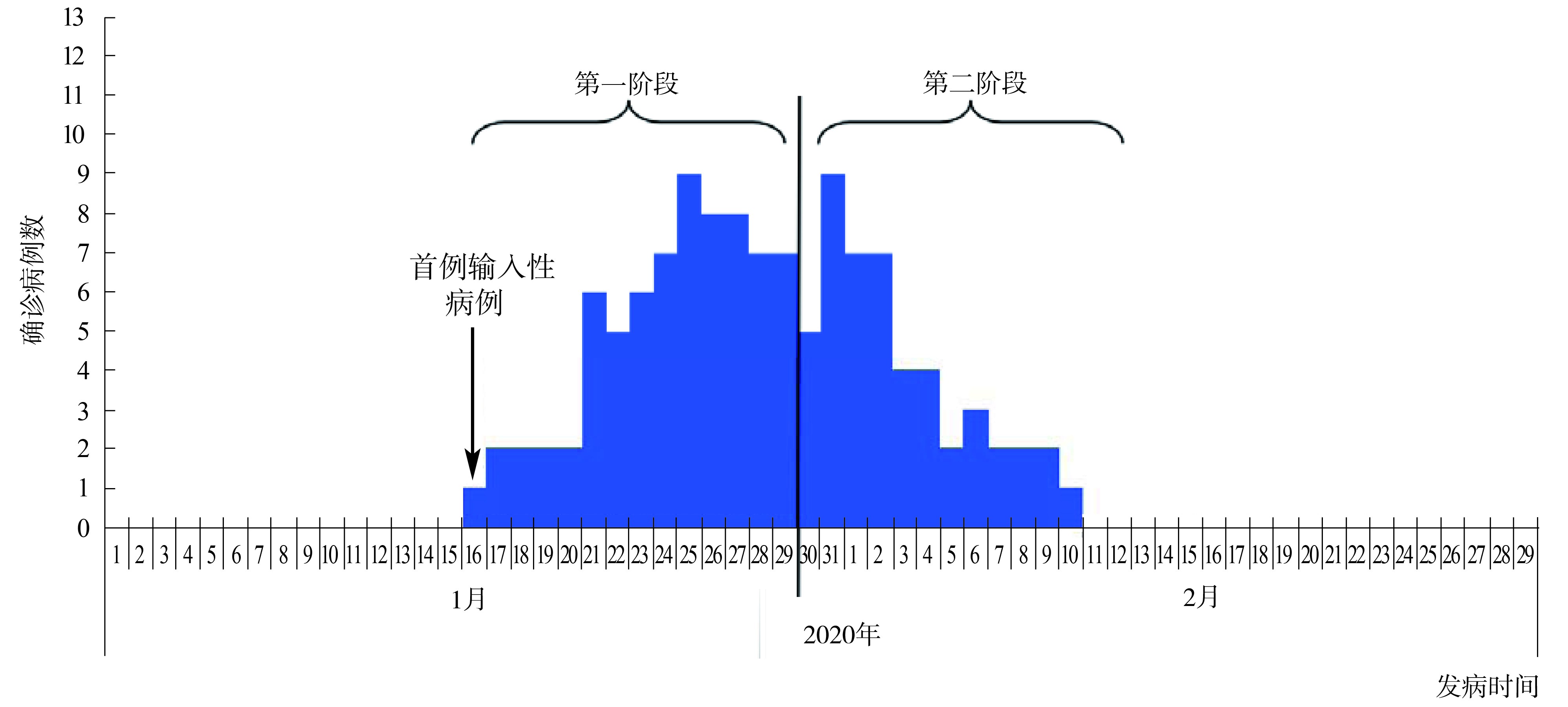Analysis on the epidemiological characteristics of an outbreak of coronavirus disease 2019(COVID-19) in Xi'an
-
摘要:
目的 探讨西安市新型冠状病毒肺炎(COVID-19)疫情的流行规律, 为优化疫情防控策略提供科学依据。 方法 采用Excel 2007、SPSS 18.0、ArcGIS 10.3软件对COVID-19疫情数据进行描述性流行病学分析; 采用内插法计算COVID-19的潜伏期。 结果 西安市截至2020年3月6日累计报告COVID-19确诊病例120例、疑似病例738例, 报告发病率约为1.20/10万; 死亡1例, 病死率为0.83%。确诊病例以轻症为主(92.50%), 男性发病数(63例)多于女性(57例), 41~50岁病例数最多(21.97%)。发病高峰出现在2020年1月25日和1月31日。高发病地区主要分布在主城区的4个街道办事处(21.67%, 26/120)。108例出院病例的平均住院时间为16.00(15.58±5.45)d。全市累计发生23起聚集性疫情, 二代病例的平均续发率为31.73%, 其中13起(56.52%)的聚集性疫情发生在家庭内。西安市COVID-19的平均潜伏期为9 d。累计报告无症状感染者25例, 占SARS-Cov-19感染者的比例为17.24%(25/145)。 结论 西安市COVID-19疫情整体划分为二个阶段, 病例呈现随机的灶状分布, 未出现当地大范围传播, 需警惕家庭聚集性和无症状感染者传播的风险。 Abstract:Objective To explore the epidemic feature of an outbreak of 2019 novel coronavirus diseases(COVID-19) in Xi'an, so as to provide scientific basis for optimizing the control strategy of COVID-19. Methods Excel 2007, SPSS 18.0 and ArcGIS 10.3 software were used to describe the distribution of the disease as well as aggregated epidemic feature. The latent period of COVID-19 in Xi'an was calculated by interpolation method. Results By March 6 th, 2020, a total of 120 confirmed cases, 738 suspected cases of COVID were reported in Xi'an, with an average incidence of 1.20 per 100 000, and 1 death case with the case-fatality rate of 0.83%. There were more male cases(63) than female(57), most mild cases(92.50%) and aged 41-50 years old cases(21.97%) among confirmed cases. The epidemic curve show that the peak occurred on January 25 th as well as January 31 th, 2020, respectively. The high incidence area was mainly distributed in the four subdistricts of the main urban area of Xi'an city(21.67%, 26/120). The average time of stay in hospital of 108 discharged cases was 16.00 days(15.58±5.45 days). A total of 23 clusters of COVID-19 were occurred in Xi'an, with the average rate of recurrence of the second generation of cases was 31.73%, of which 13 outbreaks(56.52%) occurred in families. The average incubation period of COVID-19 in Xi'an was calculated as 9 days. A total of 25 cases of asymptomatic infection were reported, and accounted for 17.24% of those infected with the 2019 novel coronavirus. Conclusion The overall epidemic curve of Xi'an is divided into two stages. The cases are distributed in random focalization, and there is no local spread in Xi'an. It is necessary to be alert to the risk of family clustering and asymptomatic transmission. -
表 1 西安市COVID-19聚集性疫情发生情况
Table 1. The situation of clusters of COVID-19 in Xi'an
类型 疫情起数 涉及病例总数 二代病例数 易感人数 续发率(%) 家庭内 13 38 18 52 34.62 商场场所 3 18 3 14 21.43 聚餐聚会 3 20 5 11 45.45 工作场所 1 4 3 9 33.33 交通工具 1 4 2 7 28.57 社区感染 1 3 1 5 20.00 院内感染 1 2 1 6 16.67 合计 23 88 33 104 31.73 表 2 西安市COVID-19确诊病例的潜伏期及暴露日期估算
Table 2. Calculation of incubation period and exposure date of COVID-19 confirmed cases in Xi'an
日期 新发病例数(f) 累计病例数(∑ f) 占比%(P) 1月16日 1 1 0.83 1月17日 2 3 2.50 1月18日 2 5 4.17 1月19日 2 7 5.83 1月20日 2 9 7.50 1月21日 6 15 12.50 (PB16%) 1月22日 5 20 16.67 (PO16%) 1月23日(M1) 6 26 21.67 1月24日 7 33 27.50 1月25日 9 42 35.00 1月26日 8 50 41.67 1月27日(M0) 8 58 48.33 (PB50%) 1月28日 7 65 54.17 (PO50%) 1月29日 7 72 60.00 1月30日 5 77 64.17 1月31日 9 86 71.67 2月1日 7 93 77.50 2月2日 7 100 83.33 (PB84%) 2月3日(M2) 4 104 86.67 (PO84%) 2月4日 4 108 90.00 2月5日 2 110 91.67 2月6日 3 113 94.17 2月7日 2 115 95.83 2月8日 2 117 97.50 2月9日 2 119 99.17 2月10日 1 120 100.00 -
[1] World Health Organization. Coronavirus Available[EB/OL]. (2020-01-18)[2020-01-19]. https://www.who.int/health-topics/coronavirus. [2] Bogoch II, Watts A, Thomas-Bachli A, et al. Pneumonia of Unknown Etiology in Wuhan, China: Potential for International Spread Via Commercial Air Travel[J]. J Travel Med, 2020(1), 1-3.DOI: 10.1093/jtm/taaa008. [3] World Health Organization. Novel coronavirus disease named COVID-19[EB/OL]. (2020-02-11)[2020-02-27]. https://www.who.int/emergencies/diseases/novel-coronavirus-2019/events-as-they-happen. [4] 中华人民共和国国家卫生健康委员会.新型冠状病毒肺炎防控方案(第五版)[EB/OL]. (2020-02-21)[2020-02-21]. http://www.nhc.gov.cn/jkj/s3577/202002/a5d6f7b8c48c451c87dba14889b30147.shtml.National Health Commission COVID-19 prevention and control program(Fifth Edition)[EB/OL]. (2020-02-21)[2020-02-21]. http://www.nhc.gov.cn/jkj/s3577/202002/a5d6f7b8c48c451c87dba14889b30147.shtml. [5] 中华人民共和国国家卫生健康委员会.新型冠状病毒肺炎诊疗方案(试行第七版)[EB/OL]. (2020-03-04)[2020-03-04].http://www.nhc.gov.cn/yzygj/s7653p/202003/46c9294a7dfe4cef80dc7f5912eb1989.shtml.National Health Commission Diagnosis and treatment of COVID-19(trial version 6)[EB/OL]. (2020-03-04)[2020-03-04].http://www.nhc.gov.cn/yzygj/s7653p/202003/46c9294a7dfe4cef80dc7f5912eb1989.shtml. [6] 中国疾病预防控制中心.新型冠状病毒肺炎聚集性疫情流行病学调查指南[EB/OL](2020-02-20)[2020-2-21]. http://www.chinacdc.cn/jkzt/crb/zl/szkb_11803/jszl_11815/202002/t20200220_213405.html.Chinese Center for Disease Control and Prevention. Guide for epidemiological investigation of clusters of COVID-19[EB/OL](2020-02-20)[2020-2-21]. http://www.chinacdc.cn/jkzt/crb/zl/szkb_11803/jszl_11815/202002/t20200220_213405.html. [7] 中国疾病预防控制中心新型冠状病毒肺炎应急响应机制流行病学组, 中国疾病预防控制中心.新型冠状病毒肺炎流行病学特征分析[J].中华流行病学杂志, 2020, 2(41): 145-151.DOI: 10.3760/cma.j.issn.0254-6450.2020.02.003.Epidemiology working group for NCIP epidemic response of Chinese Disease Control and Prevention. The epidemiological characteristics of an outbreak of 2019 novel coronavirus diseases(COVID-19)in China[J]. Chin J Epidemiol, 2020, 2(41): 145-151. DOI: 10.3760/cma.j.issn.0254-6450.2020.02.003. [8] 白尧, 刘昆, 陈志军, 等.陕西省新型冠状病毒感染肺炎疫情的早期传播动力学研究[J].中华医院感染学杂志. 2020, 30(6): 834-838.DOI: 10.11816/cn.ni.2020-200218.Bai Y, Liu K, Chen ZJ, et al. The early transmission dynamics of the 2019 novel coronavirus outbreak in Shaanxi Province[J]. Chin J Nosocomio, 2020, 30(6): 834-838. DOI: 10.11816/cn.ni.2020-200218. [9] Benvenuto D, Giovanetti M, Ciccozzi A, et al. The 2019-new coronavirus epidemic: evidence for virus evolution[J]. J Med Virol, 2020, 92(4): 455-459.DOI: 10.1002/jmv.25688. [10] Xiong CL, Jiang LF, Chen Y, et al. Evolution and variation of 2019-novel coronavirus[J]. bioRxiv, 2020.DOI: 10.1101/2020.01.30.926477. [11] Guan WJ, Ni ZY, Hu Y, et al. Clinical characteristics of 2019 novel coronavirus infection in China[J]. medRxiv, 2020.DOI: 10.1101/2020.02.06.20020974. [12] 董晓春, 李佳萌, 柏建芸, 等.天津市新型冠状病毒肺炎确诊病例流行病学特征分析[J].中华流行病学杂志, 2020.41(5): 638-642.DOI: 10.3760/cma.j.cn112338-2020221-00146.Dong XC, Li JM, Bai JY, et al. Epidemiological characteristics of confirmed COVID-19 cases in Tianjin[J]. Chin J Epidemiol, 2020. 41(5): 638-642. DOI: 10.3760/cma.j.cn112338-2020221-00146. [13] Hu ZY, Song C, Xu CJ, et al. Clinical characteristics of 24 asymptomatic infection with COVID-19 screened among close contacts in Nanjing, China[J]. medRxiv, 2020.DOI: 10.1101/2020.02.20.2002561. [14] 高文静, 李立明.新型冠状病毒肺炎潜伏期或隐性感染者传播研究进展[J].中华流行病学杂志, 2020, 4(41): 485-488.DOI: 10.3760/cma.j.cn112338-20200228-00207.Gao WJ, Li LM. Advances on presymptomatic or asymptomatic carrier transmission of COVID-19[J]. Chin J Epidemiol, 2020, 4(41): 485-488. DOI: 10.3760/cma.j.cn112338-20200228-00207. [15] 吴伟慎, 李永刚, 魏兆飞, 等.天津市某百货大楼新型冠状病毒肺炎聚集性疫情调查分析[J].中华流行病学杂志, 2020.41(4): 489-493.DOI: 10.3760/cma.j.cn112338-2020221-00139.Wu WS, Li YG, Wei ZF, et al. Investigation and analysis on characteristics of a cluster of COVID-19 associated with exposure in a department store in Tianjin[J]. Chin J Epidemiol, 2020. 41(4): 489-493. DOI: 10.3760/cma.j.cn112338-2020221-00139. -





 下载:
下载:


